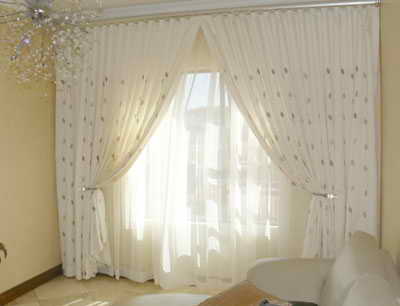How to Make and Hang an Austrian Blind
- Cut 1 piece of the main fabric and 1 piece of the lining to the required measurements. If more than 1 width is required, join them together using a flat seam and matching the pattern if necessary. Press the seams open. Make sure there is a full width in the centre with equal part widths added at each side.
- To make the frill join the strips together with a 0.5" (12 mm) French seam to make one long length, matching the pattern where necessary. Neaten each end by turning in a double 0.25" (6 mm) hem and stitch. Turn up a double 0.25" (6 mm) hem along the bottom edge, pin, stitch and press. Work 2 rows of gathering stitches along the top edge. Pull up the gathering threads until it measures twice "A" + "B". Adjust the gathers evenly.
- Lay the blind fabric, right side up, on a flat surface. Starting 1" (2.5 cms) down from the top edge, lay the frill onto the blind, wrong side up, with the frills facing towards the centre and matching the raw edges.
· Working
down one side, across the bottom and then up the other side, pin the frill into
place, finishing 1" (2.5 cms) from the top edge at the other side. Adjust
the gathers if necessary to help ease the frill around the corners.
· Machine
stitch into place, 0.5” (12 mm) in from the raw edges, between the 2 rows of
gathering stitches. Remove the gathering threads.
· Lay the
blind, right side up, on a flat surface with the frills facing towards the
centre. Place the lining, wrong side up, on top. Position it so that the raw
edges match along the bottom and side edges.
· Pin and
stitch through all thicknesses around all 3 edges, 0.5" (12 mm) in from
the raw edges.
· Turn right side out and press lightly.· Lay the blind, lining side up, onto a flat surface. Cut 2 lengths of Austrian blind tape slightly longer than the length of the blind, making sure that the first loop on the tape will be 2" (5 cms) up from the frill seam. Position the tapes vertically on the fabric, alongside the frill seam at each side. Make sure that the loops of the tape are aligned across the blind. Turn under 0.5" (12 mm) at the bottom edge of each tape to neaten.
· Pin and stitch the tapes in place. Stitch both sides in the same direction to avoid puckering.
· Divide the width between the Austrian blind tapes into equal sections of 12" - 20" (30 - 50 cms) and mark a vertical line down the blind at each point.
· Pin and
stitch a length of Austrian blind tape centrally on each vertical line, turning
under 0.5” (12 mm) at the bottom edge to neaten. Make sure that the tapes are
parallel and that the loops on all the tapes are aligned across the blind.
· Lay the
blind, lining side up, onto a flat surface. Turn down 1" (2.5 cms) at the
top edge and press the fold.
· Knot
the cords, to the wrong side, at one end of the heading tape and free them to
the right side, at the other end. Pin the heading tape on the wrong side of the
blind, close to the top fold, turning in 1" (2.5 cms) at each end to
neaten.
· Insert
a cord tidy bag, approximately 2" (5 cms) in from the edge where the cords
are free.
· Stitch the heading tape in place along the
top and bottom edges, making sure to stitch both sides in the same direction to
avoid puckering.Hanging an Austrian Blind:
· Decide
from which side of the window you wish to work your blind i.e. left or right.
These instructions are for a right-handed operation; just reverse the
instructions for a left-handed operation.
· Lay the
blind, lining side up, onto a flat surface. Cut pieces of nylon cord for each
length of the Austrian blind tape. Cut each piece twice the length of the blind
+ 1 width.
·
Starting at the right hand side, attach a piece of nylon cord to the
bottom loop of the Austrian blind tape and thread it up through all the loops
to the top edge.
· Repeat
for the other blind tapes.
· Pull up
the cords on the heading tape to fit the blind track or batten and adjust the
gathers evenly. Secure the ends of the cords with a sliding loop. Wind up the
surplus cord and tuck it into the cord tidy bag.
· Attach
the top of the blind to the wooden batten, by pressing the heading tape onto
the grip tape. Screw the eyes into the underside of the wooden batten, directly
above each of the Austrian blind tapes. If using an Austrian blind track insert
curtain hooks into the pockets on the heading tape and hang the blind on the
track.
· Thread
all the nylon cords through the cord holders on the track or the screw eyes on
the batten, working from left to right. With the bottom of the blind at window
sill level, cut all the nylon cords level with the bottom of the window. Thread
all the cords through the acorn and knot to secure.
· Fix a cleat at the right hand side
approximately halfway down the window. Pull up the blind and wind the cords
around the cleat in a figure of eight to secure.





.jpg)




















.jpg)





















